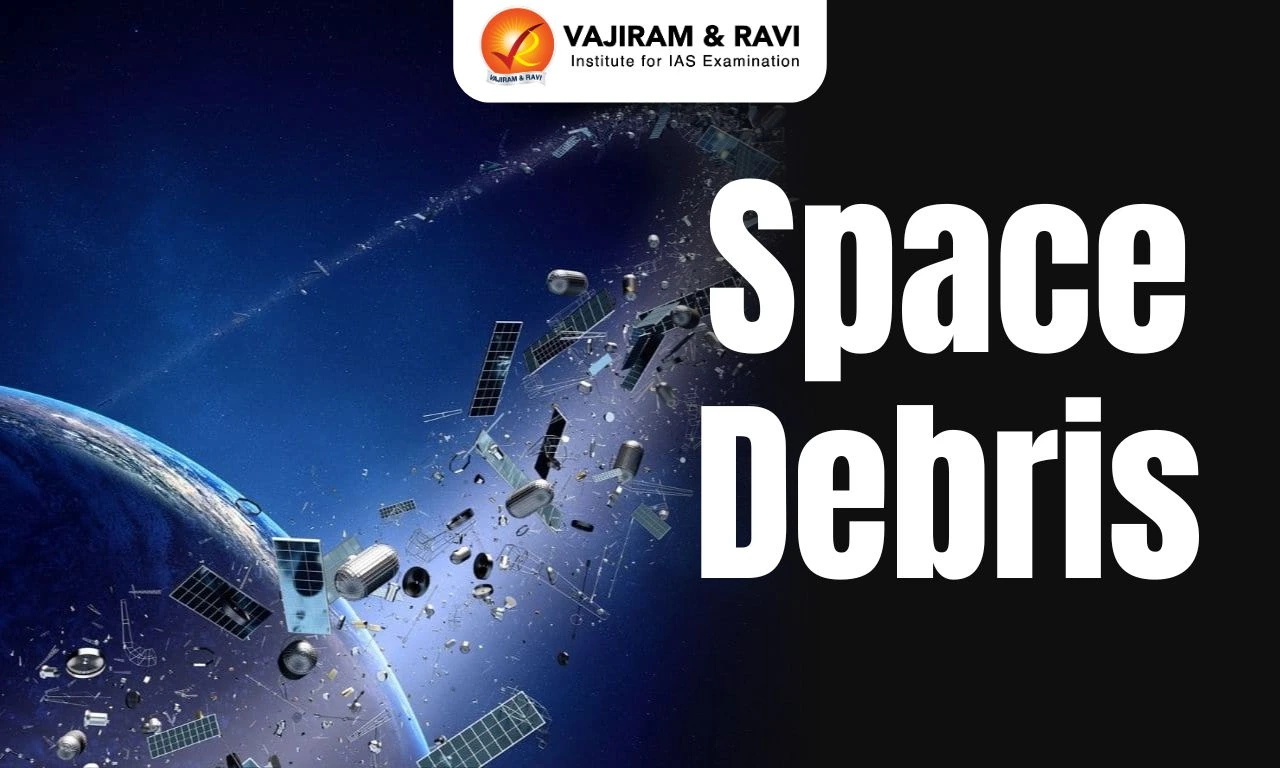Space debris, also known as space junk, refers to any non-functional or discarded human-made objects in space, including defunct satellites, spent rocket stages, fragments from previous collisions, and paint flecks. As human ventures into space have intensified, the issue of space debris has taken centre stage.
These objects of space debris remain in various orbits around Earth and pose potential threats to operational satellites and space missions.
What is Space Debris?
It is also known as space junk, which is any piece of machinery or debris left in space by humans. It can refer to large objects such as dead satellites and smaller items, such as debris or paint flecks that have fallen off a rocket.
- The majority of space debris consists of rocket-launching material and decommissioned satellites.
- The majority of the debris is in the Low Earth Orbit (LEO), within 2,000 kilometres of the Earth's surface, though some are in the Geostationary Orbit (35,786 kilometres above the Equator).
Current Status of Space Debris
- Space debris: As per ESA's Space Environment Report 2022, over 30,000 pieces of space debris have been recorded and are being tracked on a regular basis by space surveillance networks.
- Micro debris: It is estimated that there are approximately 200,000 pieces ranging in size from 1 to 10 cm, with millions more smaller than 1 cm.
- In addition to this, there are about 34,000 objects greater than 10 cm
- Growth of satellite constellations: There were approximately 6,718 active satellites orbiting the Earth in 2022, an increase of nearly 2,000 satellites in just one year.
Causes for Space Debris
Space debris has become an increasing problem in Earth's orbit due to increased human activities in space. The following are the causes of the rise in space debris:
- Launching objects into Space: The space debris issue has intensified due to the rapid increase in the number of satellites launched into space.
- For instance, Starlink internet satellites from SpaceX now account for half of all active satellites in Earth orbit.
- Further, nearly 12,000 satellites are planned to be deployed, with a possible later extension to 42,000.
- For instance, Starlink internet satellites from SpaceX now account for half of all active satellites in Earth orbit.
- Abandoned satellites: Some satellites are decommissioned and become defunct after their functional operations and they end up as part of the growing collection of space junk.
- According to the Natural History Museum, there are nearly 3,000 decommissionedsatellites in space.
- Anti-satellite tests: Several countries, such as the USA, China, and India, have conducted anti-satellite tests, using missiles to destroy their own satellites. This has led to deliberate space debris creation.
- For instance, in 2007, the Chinese FengYun-1C mission alone increased the population of trackable space objects by 25%.
- Increasing expansion: The space industry is booming, with both public and private sectors investing heavily in space exploration.
- Long-lasting mission debris: Space debris caused by satellite missions in LEO might return to the atmosphere of the Earth. However, debris at higher altitudes, like geostationary orbits, can orbit the Earth for a longer period.
- Fragmentation of space debris: One of the significant factors responsible for the rise in space debris is the fragmentation of space debris due to collision, explosion and degradation.
Threats and Challenges Posed by Space Debris
Space debris, while not an imminent apocalypse, presents several substantial threats and challenges to space exploration.
- Satellite endangerment: Space debris can collide with operational satellites, potentially causing severe damage, mission interruption, or even satellite destruction.
- For instance, in 1981, the Russian Cosmos-1275 satellite was the first to be damaged due to a collision with space debris.
- In 2013, the GOES-13 satellite of the U.S. Space Force was also destroyed by space debris
- Kessler Syndrome: Growth in space debris increases the risk of collisions between space objects.
- It can trigger the chain reaction of the theoretical concept of Kessler syndrome, resulting in the overpopulation of the Earth's orbit with objects and debris.
- This will make the Earth’s orbit unusable.
- Limitations on future space activities: The growing issue of space debris may result in the reduction of orbital slots for space activities.
- It potentially limits the ease and freedom of launching new missions or expanding space-based operations, as most orbital debris resides within LEO.
- Space station vulnerability: Space debris poses threats to the Space stations and the safety of Astronauts.
- For instance, as per NASA report, the International Space Station (ISS) has corrected its course 32 times since 1999 to avoid satellites and trackable space debris.
- Space pollution: The accumulation of space debris in Earth's orbit contributes to long-term orbital pollution, which not only complicates space activities but also raises environmental concerns for future generations of space explorers.
- Tensions between countries: With the increased participation of countries in space activities, disagreements may arise over who is responsible for reducing space debris and who is responsible for paying damages when spacecraft from different countries collide.
- For instance, the United States accused Russia of endangering the ISS following an anti-satellite weapons test.
Space Debris Removal
Space debris is a critical issue for the safety of operating satellites and the long-term sustainability of space activities. Some initiatives to deal with space debris include
International Initiatives
- Space Industry Debris Mitigation Recommendations:
- All LEO spacecraft operators should strive for a post-mission disposal process with a success rate of 95-99% or higher.
- Collision Avoidance Measures: Spacecraft operators should actively employ measures to reduce the risk of collisions with satellites and space debris, utilising appropriate technology promptly and effectively.
- Data Sharing for Orbital Traffic Management: Space agencies should collaborate and promptly share satellite movement data to facilitate efficient traffic management in orbit.
- Incentives for Long-Term Missions: Third-party liability insurance organisations could incentivise long-term missions, encouraging sustainable practices in space endeavours.
- Implementation of Safety Measures: Ensuring the establishment of proper safety protocols is crucial to maintaining a healthy standard in space operations.
- Inter-Agency Space Debris Coordination Committee (IADC): Established in 1993, it is an international governmental forum for the global coordination of activities concerning man-made and natural debris in space. ISRO is a member of the committee.
- Designing to minimise space debris production during normal operations & fragmentation due to strikes
- Employ launchers that do not pollute the LEO environment
- Active passivation of the spacecraft
- Draining of all power, fuel and energy sources
- Committee on Peaceful Uses of Outer Space (COPUOS): It is a United Nations committee established in 1958 to govern the exploration and use of space for the benefit of all humanity.
- The committee had 18 founding members, including India.
- Clean Space Initiative: It is a program launched in 2012 by the European Space Agency (ESA) that aims to ensure the sustainability of the space environment for future generations.
- Clearspace-1: The first mission to remove a piece of space debris from orbit, is planned to be launched in 2026 by the ESA.
- Liability Convention of 1972 (Convention on International Liability for Damage Caused by Space Objects): Adopted in 1972, it states that a launching State is absolutely liable to pay compensation for damage caused by its space objects on the Earth's surface or to aircraft, as well as for damage caused by its faults in space.
- Remove DEBRIS: It aims to conduct key active debris removal technology demonstrations in order to determine the best way to capture the estimated 40,000 pieces of space debris orbiting Earth.
- Outer Space Treaty: Treaty on Principles Governing the Activities of States in the Exploration and Use of Outer Space, including the Moon and Other Celestial Bodies 1967.
- Other mechanism:
- IAF Space Debris Working Group
- IAA Space Traffic Management Working Group
- ISO Space Debris Working Group
Initiatives for Space Debris Removal by India
- ISRO System for Safe & Sustainable Operations Management (IS4OM): Launched in 2022, it is ISRO's holistic approach to ensuring the safety of space assets and the continued use of outer space for national development. It monitors objects that pose collision threats.
- Project Netra (Network for Space Object Tracking and Analysis): It is an early warning system launched by ISRO in space to detect debris and other threats to Indian satellites. It can spot, track, and catalogue objects as small as 10 cm, up to a range of 3,400 km.
- Collision Avoidance Manoeuvres: In order to avoid collisions with other space objects, ISRO performed 21 collision avoidance manoeuvres of Indian operational space assets in 2022.
- ISRO SSA (Space Situational Awareness) Control Centre: It was established in 2020 to function as a hub of all space situational awareness activities within India, to ensure safe and sustainable space operations.
Measures Needed to Tackle Space Debris
Tackling the issue of space debris removal is a complex and multifaceted challenge that requires a combination of technological, regulatory, and international cooperation measures.
- Enhanced awareness: To effectively remove space debris, there is a need to upgrade observation technology and enhance the accuracy of tracking models, which will enable more precise monitoring and identification of space debris and objects in orbit.
- Improved coordination: As space traffic continues to grow, better coordination is essential. New approaches, such as automation and the establishment of "rights of way" in space, may be necessary to manage the increasing congestion in Earth's orbit.
- Minimising space debris growth: It can be managed through a combination of regulatory actions, voluntary efforts, and international agreements. Using reusable launch vehicles rather than single-use rockets can help reduce the amount of new debris produced by launches.
- Debris mitigation and active removal: It involves collecting and moving defunct or non-maneuverable debris to lower orbits, where it can naturally deorbit more quickly. Various technologies, such as harpoons, magnets, lasers, and slingshots, are being explored as potential means to capture space debris.
- For example, in April 2023, ISRO for the first time brought down a satellite, Megha Tropiques-1, in a controlled manner after its end of life.
- Adherence to international guidelines: Space actors need to follow international guidelines more rigorously, such as the International Association for the Advancement of Space Safety (IADC) space debris mitigation guidelines, 2002.
Last updated on November, 2025
→ Check out the latest UPSC Syllabus 2026 here.
→ Join Vajiram & Ravi’s Interview Guidance Programme for expert help to crack your final UPSC stage.
→ UPSC Mains Result 2025 is now out.
→ UPSC Notification 2026 is scheduled to be released on January 14, 2026.
→ UPSC Calendar 2026 is released on 15th May, 2025.
→ The UPSC Vacancy 2025 were released 1129, out of which 979 were for UPSC CSE and remaining 150 are for UPSC IFoS.
→ UPSC Prelims 2026 will be conducted on 24th May, 2026 & UPSC Mains 2026 will be conducted on 21st August 2026.
→ The UPSC Selection Process is of 3 stages-Prelims, Mains and Interview.
→ UPSC Result 2024 is released with latest UPSC Marksheet 2024. Check Now!
→ UPSC Prelims Result 2025 is out now for the CSE held on 25 May 2025.
→ UPSC Toppers List 2024 is released now. Shakti Dubey is UPSC AIR 1 2024 Topper.
→ UPSC Prelims Question Paper 2025 and Unofficial Prelims Answer Key 2025 are available now.
→ UPSC Mains Question Paper 2025 is out for Essay, GS 1, 2, 3 & GS 4.
→ UPSC Mains Indian Language Question Paper 2025 is now out.
→ UPSC Mains Optional Question Paper 2025 is now out.
→ Also check Best IAS Coaching in Delhi
Tags: quest space debris


















